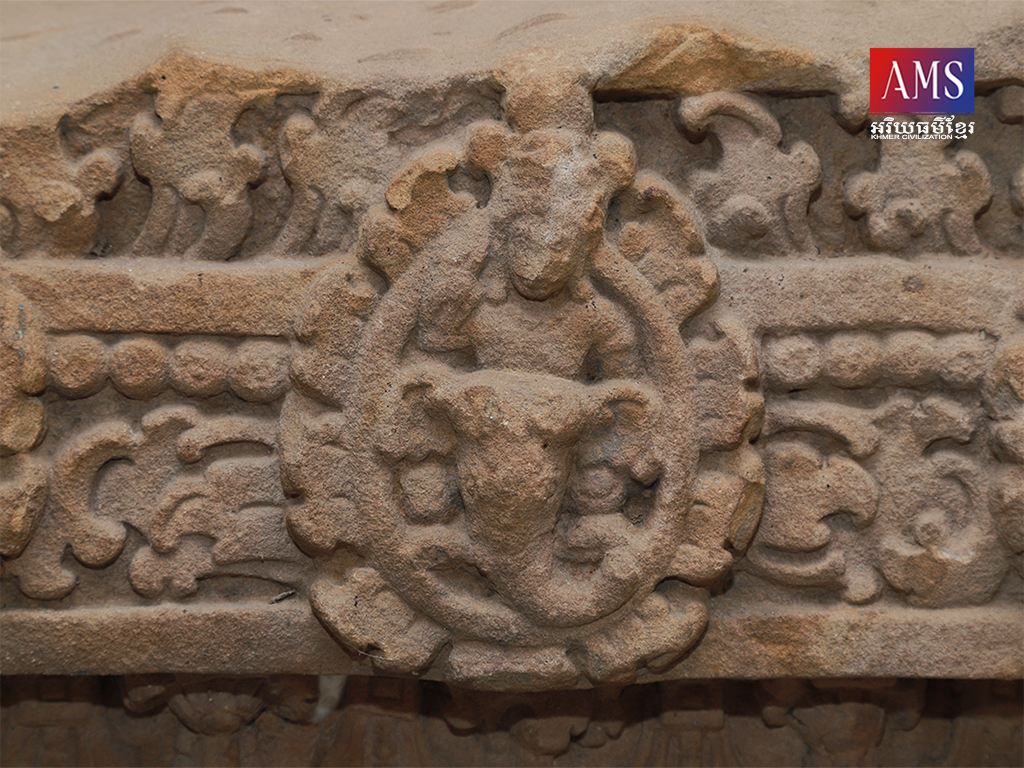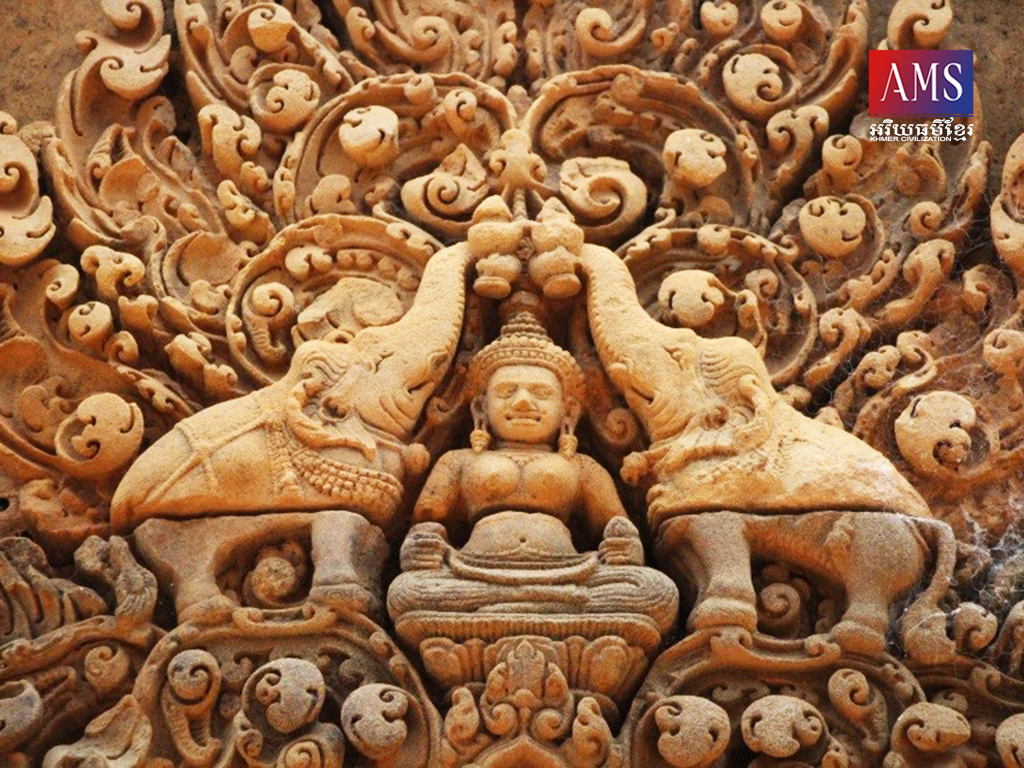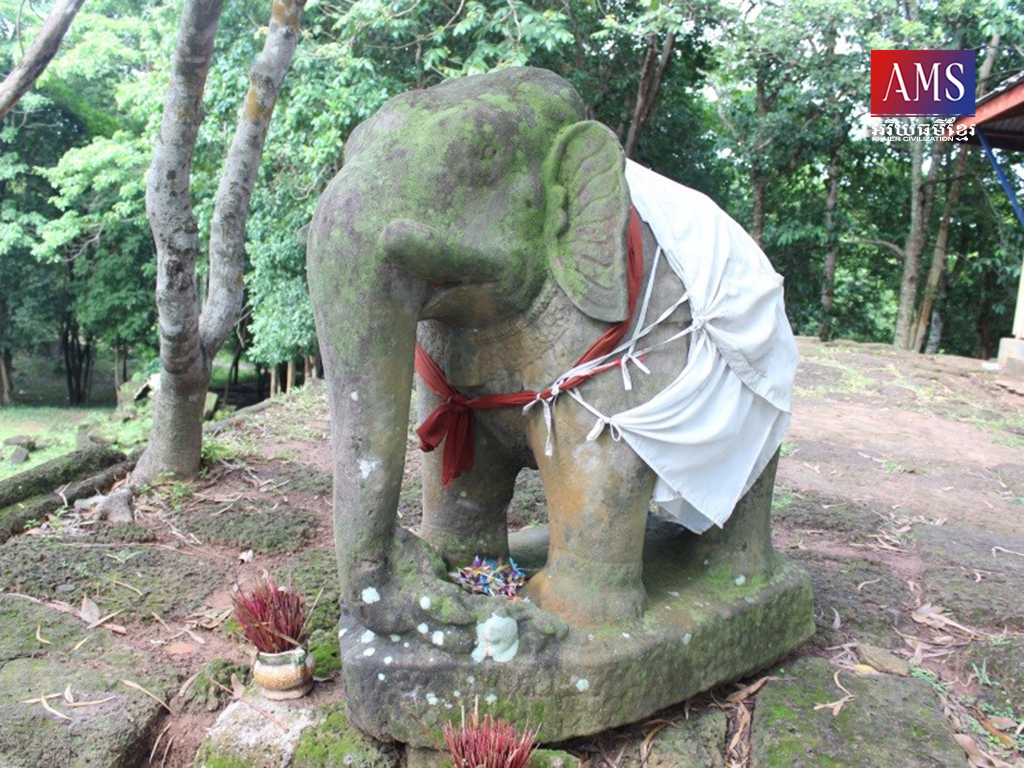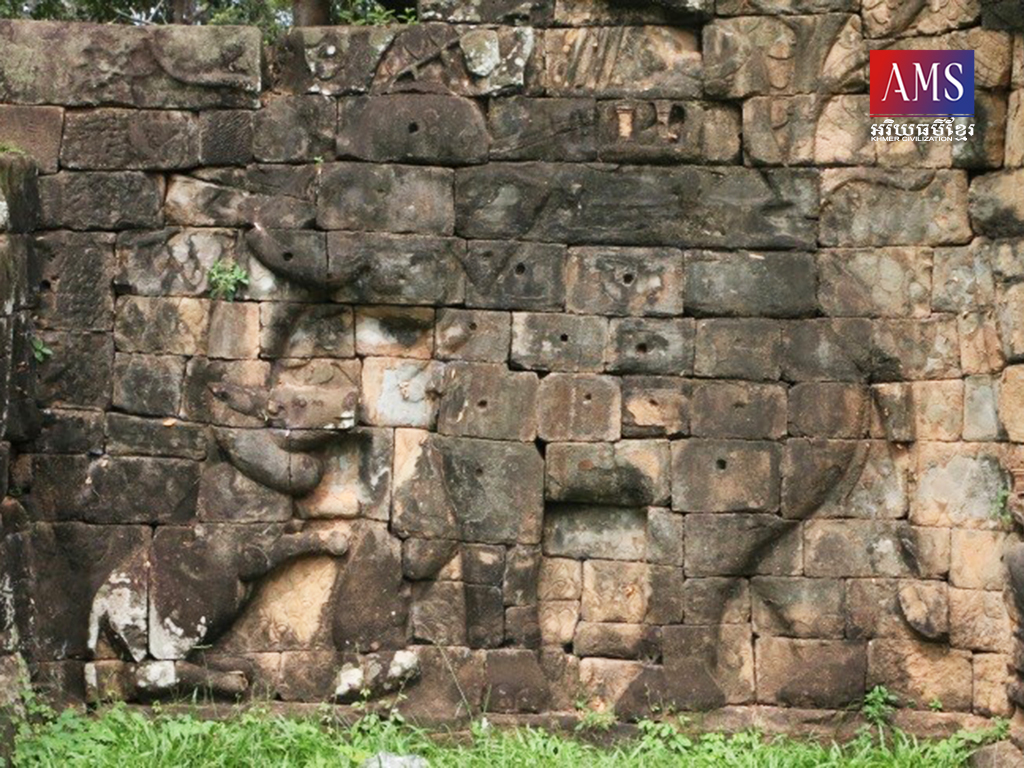ដំរី ជាសត្វមួយដែលមានភាពជិតស្និទ្ធខ្លាំងជាមួយមនុស្ស ទាំងការរស់នៅ និងកិច្ចការស្ថាបនាសំណង់នានា។ ដ្បិតគេគិតថាទោះបីដំរីជាសត្វព្រៃកាចសាហាវនិងមានកម្លាំង តែគេងាយផ្សាំងសត្វនេះយកមកប្រើប្រាស់ឱ្យមានចរឹកស្លូតបូត និងងាយប្រើប្រាស់សម្រាប់ការងារធ្ងន់ៗ មិនតែប៉ុណ្ណោះនៅសម័យបុរាណបានប្រើប្រាស់សត្វដំរីប្រើប្រាស់ក្នុងសឹកសង្រ្គាម ដូចមានបង្ហាញតាម រយៈចម្លាក់នៅតាមជញ្ជាំងប្រាសាទមួយចំនួន និងបង្ហាញតាមរយៈសិលាចារឹកទៀតផង។
ជាទូទៅចម្លាក់ទាក់ទងនឹងសត្វដំរីនៅក្នុងសិល្បៈខ្មែរ យើងឃើញមានតាំងពីស.វ.ទី៧មកម្ល៉េះ ដូចឃើញនៅតំបន់ប្រាសាទសំបូរព្រៃគុកខេត្តកំពង់ធំ។ ប៉ុន្តែ ចម្លាក់ទាំងនោះសុទ្ធសឹងបង្ហាញដំរីដែលជាយានជំនិះរបស់ព្រះឥន្រ្ទប៉ុណ្ណោះ ពោល គឺដំរីដែលកើតចេញពីការកូរសមុទ្រទឹកដោះ ដែលមានឈ្មោះថា “ព្ធវ៌ត” (រូបលេខ១)។ បន្ទាប់មក នៅស.វ.ទី១០ យើងឃើញមានការបង្ហាញចម្លាក់ដំរីស្រោចទឹកឱ្យព្រះនាងលក្ស្មី ដូចឃើញនៅលើហោជាងប្រាសាទបន្ទាយស្រី (រូបលេខ២)។
ចាប់ពីស.វ.ទី៩-១៣មក យើងឃើញគេនិយមធ្វើបដិមារូបដំរីដាក់នៅតាមជ្រុងប្រាសាទក្នុងគំនិតដែលយល់ថា ដំរីគឹជាសត្វមួយដែលជាឆ្មាំនៅចាំយាមទីស្ថានរបស់អាទិទេពនៅភ្នំព្រះសុមេរុ ដូចឃើញនៅប្រាសាទបាគង ប្រាសាទដំរីនៅកោះកេរ ប្រាសាទមេបុណ្យខាងកើត ប្រាសាទភិមានអាកាស ក្រុមប្រាសាទព្រះពិធូរ ប្រាសាទដំរីនៅបាកាណ ជាដើម (រូបលេខ៣)។ ជាងនេះទៀត ក្នុងសម័យស.វ.ទី១២មក ចម្លាក់ដំរីដែលទាក់ទងនឹងរឿងរ៉ាវព្រះពុទ្ធសាសនាក៏មានច្រើនគួរសមដែរ ដូចឃើញនៅប្រាសាទបាលីលេយ្យ។ ចម្លាក់ដំរីដែលគួរកត់សម្គាល់មួយទៀតនោះ គឺនៅព្រលានជល់ដំរី ដែលយើងឃើញចម្លាក់ទាក់ទងនឹងដំរីច្រើនណាស់ ហើយទីនោះទំនងជាកន្លែងផ្សាំងដំរី ឬហ្វឹកហាត់ដំរី ឬជល់ដំរី ឬជាកន្លែងធ្វើកិច្ចទាក់ទងនឹងសត្វដំរីដ៏សំខាន់នៅសម័យបុរាណ (រូបលេខ៥)។
ដោយឡែក ចម្លាក់សត្វដំរីដែលយើងគិតថាអាចទាក់ទងនឹងការយកដំរីប្រើប្រាស់ក្នុងសឹកសង្រ្គាម យើងឃើញចាប់ផ្តើមមាននៅស.វ.ទី១២មកដូចជា ចម្លាក់នៅជញ្ជាំងប្រាសាទអង្គរវត្ត ប្រាសាទបន្ទាយឆ្មារ ប្រាសាទបាយ័ន។ល។ នៅជញ្ជាំងប្រាសាទអង្គរវត្ត សិល្បករបានបង្ហាញចម្លាក់ក្បួនដង្ហែទ័ពចេញច្បាំង ដែលអ្នកដឹកនាំគង់ឈរនៅលើសត្វដំរី ដោយព្រះហស្តកាន់ផ្គាក់ជាអាវុធ (ទំនងជាព្រះបាទសូរ្យវរ្ម័នទី២ ដ្បិតយើងឃើញមានហែរហមដោយក្លស់ជាច្រើន) (រូបលេខ៦)។ រីឯនៅជញ្ជាំងប្រាសាទបាយ័នវិញ យើងឃើញមានរូបមេទ័ពអង្គុយនៅលើដំរីក្នុងសមរភូមិច្រើនគួរសម ហើយចម្លាក់មួយដែលគួរឱ្យកត់សម្គាល់នោះគឺ ទំនងជាមេទ័ពម្នាក់ឈរលើសត្វដំរីបាញ់ព្រួញសំដៅទៅខ្មាំងសត្រូវ (រូបលេខ៧)។ នៅជញ្ជាំងប្រាសាទបន្ទាយឆ្មារឯណោះវិញ ក៏មានបង្ហាញចម្លាក់មេទ័ពដឹកនាំទ័ពចេញច្បាំងអង្គុយនៅលើសត្វដំរី ដោយយកដៃចង្អុលទៅកាន់អ្វីមួយ និងមានចម្លាក់មួយផ្ទាំងទៀតបង្ហាញមេទ័ពម្នាក់អង្គុយលើសត្វដំរី ដោយមានដៃកាន់ព្រួញបម្រុងនឹងបាញ់ (រូបលេខ៩)។ ចំពោះនៅក្នុងសិលាចារឹកវិញ ពាក្យ “ដំរី” គេបានកត់ត្រាអក្ខរាវិរុទ្ធខុសៗគ្នាដូចជា តំរ្រិយ (K.654) តំម្ឬ (K.388) តំរេ (K.9) តំរេយ្យ (K.257) ដែលភាគច្រើនរៀបរាប់អំពីអំណោយជាសត្វដំរីរបស់ស្តេច មន្រ្តី ឬអ្នកមានសទ្ធាបុណ្យថ្វាយដល់ទេវស្ថាន។ នៅស.វ.ទី៩ ព្រះរាជាខ្មែរមួយអង្គ គឺព្រះបាទជ័យវរ្ម័នទី៣ ជាស្តេចដែលចូលចិត្តទាក់សត្វដំរីខ្លាំងណាស់ ដែលយើងអាចដឹងបានតាមរយៈសិលាចារឹកមួយចំនួនដូចជា សិលាចារឹកប្រាសាទគោកឫស្សី (K.175) រៀបរាប់ថា៖ “ព្រះមហាក្សត្រយាងទៅកាន់វិស្ណុលោក (ព្រះបាទជ័យវរ្ម័នទី៣) បានស្តេចយាងទៅចាប់ដំរីមួយក្បាលនៅព្រំប្រទល់ព្រៃព្រះកន្លោង”, សិលាចារឹកប្រាសាទគោកចក (K.521)។ ទោះបីជាយ៉ាងណា សិលាចារឹកទាំងអម្បាលម៉ានដែលបានរៀបរាប់ខាងលើ បានបង្ហាញឱ្យឃើញថា ព្រះរាជាខ្មែរមួយអង្គទ្រង់សព្វព្រះរាជហឫទ័យក្នុងការទាក់សត្វដំរី និងអ្នកមានសទ្ធាបុណ្យតែងថ្វាយសត្វដំរីដល់ប្រាសាទ ប៉ុន្តែមិនបានបញ្ជាក់ឱ្យយើងឃើញអំពីភស្តុតាងនៃការប្រើប្រាស់សត្វដំរីក្នុងសឹកសង្រ្គាមឡើយ។ ទោះបីយ៉ាងនេះក្តី មានសិលាចារឹកដ៏សំខាន់មួយចារនៅស.វ.ទី៧ ដែលជាឧទាហរណ៍មួយបញ្ជាក់ឱ្យយើងឃើញថា ព្រះរាជាខ្មែរនៅសម័យបុរាណបានបញ្ជាឱ្យគេចាប់សត្វដំរីមកផ្សាំង ដើម្បីទុកប្រើប្រាស់ក្នុងសមរភូមិប្រយុទ្ធ។ សិលាចារឹកនោះចារនៅមេទ្វារប្រាសាទភ្នំហាន់ជ័យ ខេត្តកំពង់ចាម ចុះបញ្ជីលេខ K.81 ដែលគាថាខាងលើមករៀបរាប់ពោលសរសើរពីគុណលក្ខណៈសម្បត្តិជាច្រើនរបស់ព្រះបាទភវវរ្ម័នទី១ (គ.ស.៥៩៨-៦០៦) ក្នុងកិច្ចការគ្រប់គ្រងជាតិកាលទ្រង់ជាព្រះមហាក្សត្រនៅជំនាន់នោះ។
ជារួមមក នៅសម័យបុរាណចាប់តាំងពីរវាងស.វ.ទី៦មក ព្រះរាជាខ្មែរជាច្រើនអង្គ ព្រមទាំងមេទ័ព ពិតជាបានប្រើប្រាស់សត្វដំរីក្នុងសឹកសង្រ្គាមពិតប្រាកដមែន ដោយយើងអាចមើលឃើញភស្តុតាងតាមរយៈសិលាចារឹកនៅស.វ.ទី៧ (សិលាចារឹកភ្នំហាន់ជ័យ) និងមើលឃើញតាមតាមរយៈចម្លាក់ជាច្រើនផ្ទាំង ជាពិសេសចម្លាក់ទាក់ទងនឹងក្បួនព្រះរាជាឬមេទ័ពគង់នៅលើសត្វដំរីដង្ហែទ័ពចេញច្បាំង នៅស.វ.ទី១២ (ប្រាសាទអង្គរវត្ត) និងចម្លាក់មេទ័ពអង្គុយនិងឈរនៅលើសត្វដំរីក្នុងសមរភូមិប្រយុទ្ធជាមួយខ្មាំងសត្រូវ ដូចឃើញនៅចម្លាក់ប្រាសាទបាយ័ន និងប្រាសាទបន្ទាយឆ្មារដែលបានបង្ហាញខាងលើស្រាប់។ ចម្លាក់ និងសិលាចារឹកដែលបង្ហាញដោយសង្ខេបនេះ បង្ហាញឱ្យឃើញពីភាពប៉ិនប្រសប់របស់បុព្វបុរសខ្មែរក្នុងការផ្សាំងសត្វដំរីព្រៃដ៏កាចសាហាវយកមកប្រើប្រាស់ក្នុងជីវភាពប្រចាំថ្ងៃ និងប្រើប្រាស់ក្នុងសឹកសង្រ្គាមជាមួយសត្រូវដើម្បីការពារជាតិមាតុភូមិកម្ពុជា៕
——————————————————
Usage of elephant in warfare based on bas-relief and inscription
An elephant is a strong wild animal and can be tamed for domestication. Based on bas-reliefs and inscriptions, historically, elephants were used as instruments of war.
The figure of elephants shown in Khmer art since the 7th century. For instance, the art from Sambo Prei Kuk, Kampong Thom province. However, those reliefs show only Airavata, the mount of God Indra. In the 10th century, there are reliefs of elephants pouring water on Lakshmi. For instance, the relief from the Banteay Srei temple. In the 9th to 13th century, statues of elephants were placed at the corner of the temples as a temple’s guardian or the guardian of the place of Gods, Meru. Those examples could be seen at some temples such as Bakong, Prasat Damrek at Koh Ker, East Mebon, Phimeanakas, Preah Pithou group, and Prasat Damrei at Bakan. Besides, there are many bas-reliefs of elephants related to Buddhism. For instance, the elephant from Prasat Palilay. Many elephants were carving at the terrace elephants. Those reliefs show the place for taming elephants, fighting elephants, or the place to do ritual practices related to the elephant in the past.
The war elephants appeared in the 12th century based on bas-reliefs from Angkor Wat, Banteay Chhmar, and Bayon temple. In Angkor Wat temple, war elephants walk along with the soldiers to the battlefield. A man who was probably King Suryavarman II standing on the back of an elephant and holding a Machete. Similarly, on the bas-reliefs of the Bayon temple, generals were sitting on the back of the elephants. One among them, a general was standing on the elephant and shooting the arrow at an enemy. At Banteay Chhmar temple, the relief of a general is shown sitting on the back of an elephant and pointing to something. Another relief shows a general on an elephant and ready to shoot the arrow.
According to inscriptions, the word elephant is shown many times and with different writing. For instance, Taṃrriya in K.654, Taṃmra in K.388, Taṃre in K.9 and Taṃreyy in K,275. Those inscriptions describe the offering of the elephant to the temple by the Kings and the officials. In the 9th century, there was a King named Jayavarman III. He liked hinting at the elephant. Based on K.175, King Jayavarman III went hunting the elephant on the border of Vrai Kanloṅ. Kok Chak inscription, K.521 shows in 772 Caka, King Sri Jayavarman, who went to Vishnuloka and a son of King Paramesvara went to Vrai Sla to hunt the elephant. However, the elephant fled to the forest of Vishnugrama. The king decided to rest overnight in the area. He made a wish for finding the elephant. In the night he dreamed of Vraḥ Kamraten Añ Vaisṇava (God Vishnu), who told him to build his statue in exchange for him showing the elephant. In the morning, the King found and caught that elephant. Next, the King ordered his officials to build and erect a statue of Sakabrahmana and then named the village Vishnugrāma. Then, he offered land near Jnang Prang for the temple and God.
The most important information of taming the elephant shows in Prasat Phnom Han Chey inscription, K.81. It illustrates the good works of King Bhavavarman I (598-606 CE). Among them, the 5th stanza says, the king caught the elephant to use in warfare. The elephant has a trunk that wet by holy water. It could be compared to the hand that is wet by holy water every time of donating.
អត្ថបទដើម៖ លោក ម៉ង់ វ៉ាលី












